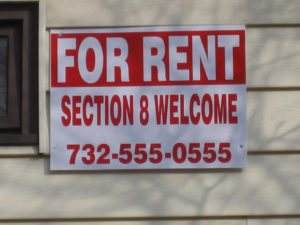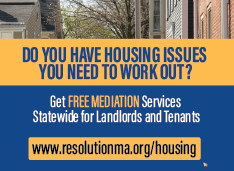A Landlord’s Guide to Section 8 in Massachusetts
Section 8, which includes the Housing Choice Voucher Program, is a federal rent subsidy that can be given to renters or apartments. When an applicant for an apartment says, “I have Section 8,” they may mean either this federal program, the Massachusetts Rental Voucher Program (MRVP), or the Veterans Affairs Supportive Housing (VASH) program. These programs are different from Section 8 in their funding source and requirements, but all provide similar kinds of permanent rental subsidy. This article will focus solely on the Section 8 housing program.

"For Rent, Section 8 Welcome." This NJ owner may have posted this sign in retaliation for NIMBY zoning restrictions, knowing that the zoning board would be afraid of or angry with Section 8 renters in the neighborhood. Or he might have wanted to encourage more applications. Metuchen Matters CC-BY-SA. Image modified to obfuscate owner's original phone number.
Section 8 in a Nutshell
A tenant with a valid Section 8 voucher will automatically pass most rental application income screens. By design, the program will ensure that the applicant’s gross income to rent ratio will be three. You will be given an inspection and lease riders. You will collect some rent from the tenant, and the government will deposit the rest into your bank account.
Starting Section 8: The Process
The apartment must be advertised at or below “fair market rent” for the area, given the condition of the apartment. The fair rent levels for a region are published by the Department of Housing and Urban Development (HUD). These may be reduced based on the age of the apartment.
The tenant will approach the landlord and will often ask, “Do you accept Section 8?” This is a trap for the unwary. Federal law does not require owners to accept a Section 8 renter. But Massachusetts law does, see section below on discrimination. (Most renters who ask are not trying to trap the owner; they are frustrated by owners who, ignorant of the law, say, “I don’t accept Section 8.” The renters just want to cut to the chase. The correct answer is, “Yes, I accept Section 8.”)
You will screen the prospective renter for everything as you normally would except income. For instance, Section 8 does not pay for security deposits (the renter must have cash saved if you intend to take deposits). So you can screen on cash available. You can screen on credit. You can screen on criminal. When you get to income, you only need to verify that their voucher is valid.
If you agree to take them, the tenant will tell their public housing agency (PHA) or subsidy administrator that they need to have an apartment inspected. The PHA will inspect the apartment against state and/or federal requirements.
If the apartment fails, you will have to make repairs. See below on inspections. When the apartment passes, you will be invited to enter a one-year lease with the renter. The lease will have riders particular to the “Housing Assistance Payment”, aka the HAP contract. For instance, victims of domestic violence will receive special treatment during eviction. You will not find out the rent split between government and renter until lease signing. The minimum rent payment any renter can make is around $25.
The PHA will direct-deposit the government’s portion of the rent into the landlord’s bank account each month. The landlord must collect the tenant’s portion of the rent from the tenant.
Each year or every two years, both the landlord and the renter must re-certify. Renter re-certification requires them to demonstrate their income and assets. Landlord re-certification requires a new apartment inspection.
If you have any problems with the renter, you cannot expect the PHA to help. You must file for eviction and carbon-copy the PHA. It is possible for a renter to lose their subsidy for bad behavior, but it is rare. Additional legal requirements may apply depending on the program. Contact an attorney before taking any action that could affect your rights in a Section 8 tenancy.
Policy Background
Section 8 of the Housing Act of 1937 (42 USC Section 1437f), as amended, authorizes the Executive Branch of the federal government to pay rent to private landlords on behalf of low-income households. Funds are distributed first by the US Department of Housing and Urban Development. The program was envisioned as a Great Depression safety net, and later expanded as part of Johnson’s Great Society.
The money flows from the United States Treasury to the Department of Housing and Urban Development, where it is assigned to a local Public Housing Agency, who direct-deposits the funds into your bank account.
Section 8 is a lifetime endowment, so long as the renter doesn’t earn too much money or become too rich. For this reason, there is a long waitlist for funding. In Massachusetts, renters typically wait eight to twelve years for Section 8.
Compared with other subsidies, Section 8 is considered highly effective at stabilizing a low-income household. The program pays as much as is required for life so long as the rent is fair, the apartment meets standards, and the renter needs the help. Other programs like HomeBASE, RAFT, security deposit funds, or vacancy repayments are short-lived and usually inadequate for long-term stability.
A major concern with Section 8 is that renters who start to earn more money will lose their subsidy. This creates a disincentive to improve household income by taking on additional people or getting more work hours. A “Section 8 version 2.0” might scale down the subsidy less quickly as income increases, to encourage self-sufficiency.
Unlike with some other programs, economic research supports Section 8 as a net benefit to society. For every dollar spent on Section 8, between $1.1 and $1.37 is saved in the form of higher educational attainment for those children, lower medical bills for that family, and lower social service costs overall (The Benefits and Costs of the Section 8 Housing Subsidy Program: A Framework and First-Year Estimates, Institute for Research on Poverty, May 2010.).
Section 8 Hidden Challenges
It is relatively easy to rent successfully to Section 8 renters, but there are serious traps for the unprepared.
Section 8 Discrimination
Under Massachusetts law, it is illegal to turn away an applicant for housing on the basis of their receiving public assistance. This means that you cannot refuse to rent to Section 8 because it’s Section 8. You can refuse to rent to a Section 8 voucher holder for other reasons.
The courts have established that you cannot refuse to participate in Section 8 by citing an unreasonable requirement of the program. For instance, if you don’t want to work with a certain PHA that has a reputation of not answering their phone, that is too bad. Massachusetts law recognizes that Section 8 is a flawed program: rather than work with HUD to fix its flaws, we have instead required compliance, however absurdly HUD or its agents may behave.
Just because someone has Section 8 doesn’t mean you have to accept them. Suppose an applicant has Section 8 but no money to pay a security deposit, and you require a security deposit for this apartment. You can safely turn away the Section 8 applicant by telling them, “Come back when you have enough for a deposit.” The same applies for criminal, credit, eviction history, or any other business-related screening practice that you apply to all applicants equally.
Remember that you cannot refuse Section 8 by citing any requirement. Many new Section 8 landlords fear their first Section 8 inspection. But you can’t say, “I won’t rent to you because I don’t want an inspection.” That would be an unlawfully discriminatory rejection. The only way to reject a Section 8 renter is for a non-Section 8 reason.
Do I Have to Approve a Section 8 Applicant?
Applicants with Section 8 vouchers can be good, long-term renters, but the state and federal protections against discrimination are hammered into landlords so forcefully that a little counterbalance is called for. Does a landlord have to approve a Section 8 applicant? No, so long as the reason for the rejection is not the Section 8 voucher.
Landlords are required by state law to participate in the Section 8 program, if a Section 8 voucher holder is the most qualified applicant. That does not mean you have to approve the rental application for anyone just because they have a Section 8 voucher. You can reject their application for the same reasons you would reject other applicants, so long as the reason is genuinely unrelated to their receipt of public assistance.
If you require a minimum credit score, no criminal record, no eviction history, or anything else that is unrelated to income or the Section 8 program, you can review the applicant on those grounds and reject if they fail. Make sure you are using an objective applicant scoring system.
Valid reasons for rejecting a Section 8 applicant:
- "We require a minimum score of X." (Then issue an adverse action letter.)
- "You were just evicted." (Housing history is not a protected class, yet.)
- "You don't have the cash to pay the security deposit." (Section 8 alone does not cover security deposits).
- "You smoke." (Applies if you don’t allow smoking for this unit. Smokers are not a protected class.)
- "You have a violent felony conviction in the last three years." (If this is your written policy, you can reject for recent and/or violent convictions material to housing.)
- "Another applicant passed and provided move-in monies." (Just make sure you process the Section 8 application as fast as possible.)
Unlawful discrimination against a Section 8 applicant:
- "Income isn't 3x rent." (The program ensures a 3x rent ratio.)
- "This unit hasn't passed inspection." (All units are inspected and you can't turn someone away because you don't want an inspection.)
- "This unit is not deleaded." (You must delead.)
- "I hate XYZ administrator." (You can't turn someone away because of any requirement of the program, including working with a bad bureaucracy.)
- “I only do month-to-month leases.” (If the Section 8 voucher administrator requires a one- or two-year lease, you can’t turn the applicant away on the basis of that requirement).
Non-rejections that may be interpreted as discrimination:
- "You might be happier renting another unit or from another landlord." (So-called "steering" of applicants is unlawful. Let the applicant decide what will make them happy.)
- "We are still accepting applications, we haven't processed yours yet." (Deliberately slow-playing Section 8 so that a market applicant gets the apartment is not allowed.)
- "I'll rent to you but for a higher rent than I advertised." (To negotiate the rent up you must have a valid reason unrelated to Section 8.)
- "The apartment is no longer for rent." (If you say this, it had better be true. You can't take it off the market the minute a Section 8 renter applies and put it back on the market when a non-Section 8 renter calls.)
- "I'll rent to you but only if you get rid of your dog." (If you would take a dog from a non-Section 8 renter, you have to take a dog from a Section 8 renter as well.)
You can reject an applicant with Section 8 if – and only if – the reason is genuinely unrelated to the program or any requirement of the program. Do not discriminate against applicants on the basis of Section 8, and do not try to disguise a discriminatory practice as non-discriminatory. So be careful considering income, as the program ensures a 3x rent ratio. Be careful of steering or slow-playing, as well.
Finally, remember that just because someone receives a subsidy does not mean that they would be a bad tenant. If any of us were to fall on hard times, we would be glad of the safety net to catch us. Screen carefully and pick the best applicant regardless of how the rent is to be paid.
Section 8 May Cover Utilities
Though the Section 8 program does not separately cover utilities, payment vouchers do take utility costs into consideration. If your rent includes utilities, these will also be covered by the Section 8 voucher you receive. If utilities are not included in the rent, your tenant may receive a different amount of subsidy to help.
“Even if utilities aren’t included in your rent, the utility amount is considered when calculating your rent share,” explains an article at bostonhousing.org. In other words, you will still get the maximum rent subsidy even if utilities aren’t included if they are still paid to your landlord alongside rent.
If your tenant will be paying utilities separately, there are also other assistance programs they can apply for, as covered in a later section.
Side Payments Are Not Allowed
When you accept a tenant who has a Section 8 voucher, you are agreeing to accept the amount of the voucher offered by Section 8, plus your tenant’s portion of the rent. These two payments must add up to the rent; anything else is illegal. If you are caught accepting side payments, the public housing agency administering your tenant’s Section 8 payments will require you to pay the tenant back. They will investigate your other Section 8 contracts, if any, to see if you accepted side payments from those tenants and, if so, you will have to repay them as well. Additionally, the agency may, at its discretion, revoke your housing assistance payment (HAP).
Housing Authorities Have Some Discretion with Allowable Rent
Section 8 payments are based on fair market value, but housing authorities and regional subsidy administrators have some discretion when it comes to setting allowable rent for a unit. They can assess an allowable rent between 90 and 110% of the fair market rent determined by HUD.
What does this mean? If your apartment passes inspection but is still run-down, you may not get the full market rent. Conversely, a modest apartment in a high property value neighborhood may net slightly more than full market rent.
“Add-Ons” Can Increase Section 8’s Power
Finding new tenants is expensive. It’s far more economical to hold onto a good tenant, and with Section 8, you’re guaranteed monthly rent at market value. Besides Section 8, there are additional programs that can help increase household stability.
For example, the SNO Mass program can help Section 8 tenants with children under age 18 find stable housing and provide assistance after they move in. Applicants who are moving must live in an area not presently declared a SNO Mass opportunity area and must be in good standing with their regional administering agency (RAA). So, if one of your tenants announces they are participating in this program, that’s fantastic news for both of you.
Your tenants may also be eligible for fuel assistance through the Low-Income Home Energy Assistance Program (LIHEAP). This program provides heating assistance and discounts on electric, gas and telephone bills for eligible participants. The program gives benefits based on household size and gross income, and can be applied for separately from Section 8.
Section 8 Criminal Screening
Some Section 8 applicants and PHA’s may tell you that they screen Section 8 applicants for criminal background. This is true but irrelevant.
First of all, the federal criteria might be less strict than you want for your rental business. For instance, to live in a housing project (Section 8 apartment), you cannot be on a lifetime sex offender registry, and you cannot have been evicted for drug offense in the last three years. You might not want sex offenders of any kind, lifetime or otherwise. You might not want any drug convictions in the last five years, or seven years.
Second, the PHA will never show you the results of the criminal screen, and they will not offer any guarantee that they have screened carefully.
For these reasons, you need to screen Section 8 applicants the same way you would any market applicant. If you screen CORI, the Section 8 renter must also submit to a CORI screen. If they refuse, you can safely decline their application.
You’re on Your Own with Section 8
Prior to leasing up your first Section 8 tenant, you may call the PHA and talk to the tenant’s caseworker. The caseworker may say things like, “We’re here to help” and “I want you to call any time you need anything.”
Sadly, what the caseworker says is irrelevant. The PHA’s and caseworkers are evaluated on their placing renters in an apartment. They are not evaluated on the average length a renter stays in an apartment, because renters may wish to move and the PHA should not feel any incentive to chain a Section 8 voucher holder down. On the contrary, the purpose of the program is housing choice.
The caseworker therefore has a perverse incentive to say anything to get you to lease up their client, and nothing afterwards. Most will say, “What would you do with a market tenant?” Many more will not even return your calls.
Some PHA’s have extremely high turnover because they place enormous case management burdens on low educational attainment case managers. It is not at all unusual to leave calls and emails for a case worker and receive no response ever. Various PHA’s have cleaned up their act, meanwhile others have fallen into managerial disrepair. PHA’s are the most frustrating aspect of Section 8. You should therefore consider yourself on your own.
The Terms of the Section 8 HAP Agreement are Seriously Flawed
Depending on the PHA and the HAP addendum to your lease, you may need to give 60 days’ notice or more to effect a rent increase. Once granted, you may receive a letter in the mail or nothing at all. They will almost certainly fail to execute a completely new rental agreement at the higher rent, putting you at risk of having improperly executed rent increases discovered in court. Despite all the bureaucracy, the paperwork can be remarkably shoddy, depending on the PHA.
If the renter fails to recertify, there will be additional headache. The renter might not complete the paperwork needed to prove they are still eligible for the Section 8 subsidy. Or they might complete the paperwork and the PHA may find the renter is making too much money, and the subsidy must be canceled. In any case, you will probably not be told anything. One day, you will notice that your direct deposit for that unit has not arrived. The government portion of the rent for that unit is now gone forever, and unless the renter can come up with the balance or move out, you must evict. Consult with an attorney.
Usually the subsidy payment is direct deposited without fail. But if you read the HAP addendum carefully, you will notice language concerning government shut-downs. If the government fails to pay its share of the rent for any reason unrelated to the renter, you will have agreed to grant the government an indefinite-term, interest-free loan. You are specifically barred from evicting the renter for non-payment under these circumstances.
Even if all the paperwork goes well, most PHA’s will not permit electronic signatures, scans, or faxes. HUD requires that documents be executed on paper, and that copies of these be stored. Many PHA’s have entire floors devoted to recordkeeping. You will have to go into the office to sign the rental agreement or do it by US mail. Expect additional delays.
Finally, there are all kinds of corner cases to keep you up at night. Here’s one we heard about recently: the renter with the subsidy committed an act of domestic violence against a household member without a subsidy. The aggressor was tried, convicted, and incarcerated, leaving the remaining household member in the unit but with no subsidy and inadequate ability to pay. Under the domestic violence protections clause, the owner feared their remaining household member would live rent-free for six months.(At time of writing, that case had not been decided.)
Many of these HAP addendum shortcomings can be avoided by carefully screening renters. It would take a coalition of PHA’s and states going to HUD to address the structural concerns.
Section 8 Inspections
Section 8 inspections take time and the results can vary by program funding and inspector.
Landlords with newer apartments will have no issue. Landlords with older apartments may suffer the “green bathtub” bias: older apartments are disproportionately more likely to be cited for non-safety issues, like missing signage, loose window sashes, or temperature anomalies (water too hot, room too cold).
Here is a list of common issues with Section 8 inspections:
- loose electrical outlets (fire and shock hazard);
- missing window screens (mosquito borne illness hazard);
- window sashes won’t stay up on their own (ventilation failure);
- stained ceilings (because they cannot tell whether a leak is active, it is presumed to be a mold hazard);
- flaking paint in pre-1978 housing (presumed to be lead);
- missing handrails or guard rails (trip and fall hazard);
- loose vinyl flooring (tripping and mold hazard);
- refrigerator missing seals (food storage hazard);
- double barrel deadbolts (egress hazard);
- heating overflow pipes do not vent within 6” of the floor (scalding hazard).
While being inspected for safety, your apartment is also being inspected for quality. The Metro Housing|Boston “Inspection Grading Guidelines” as given to MassLandlords in 2015 show the following may result in a “Grade D” apartment, which cannot be leased or renewed: roof is at the end of its life; deteriorated exterior shed; neighboring property is abandoned; “terminations often putting the client (renter) under pressure to relocate.” A “Grade A” apartment may have multiple bathrooms, a swimming pool, on-site maintenance and security, plenty of closets.
In general, inspectors try to be fair. “Grade A”s at Metro Housing|Boston are characterized by “Obvious on-going maintenance of the unit and building as well as good tenant selection practices by the owner or management.” “Grade D’s” are primarily characterized by “Little or no ongoing maintenance of the property by the owner and multiple layers of poor quality repairs exist.” Sadly, inspectors are vulnerable to human frailty, checklists are not published to landlords in advance, and one inspector’s treasuring may be another’s trashing of your apartment.
Inspections add delays to the normal market-rate lease-up process. It is possible to show an apartment, screen tenants, and sign a lease in a weekend. For Section 8, you should expect at least 7 days for an inspection, maybe 30 if you require repairs. Additional time may be required to calculate rent reasonableness and/or sign the paperwork. This creates additional vacancy cost.
Section 8 Approval, "But I'm not approved for Section 8!"
There is no Section 8 approval process for landlords or apartments. Your apartment does have to complete an inspection, but that happens with each new tenancy.
Section 8 for Apartments Instead of Renters
You may know the term “housing project.” This is an older term to describe subsidized housing, typically apartments with Section 8 vouchers tied to the unit. This means an applicant can apply without a rental subsidy, and if they are approved, they can live in the apartment with a subsidy. If they move, the subsidy stays with the apartment for the next incoming renter.
As a medium to large landlord, it is possible to get into the business of Section 8 project-based vouchers. There are application processes and timelines that you need to learn. Talk to a larger landlord in your area to learn more.
Section 8 Insurance
An additional challenge in Massachusetts can be procuring insurance. The following thoughts come from member Kevin Joyce, at time of writing at Webber and Grinnell Insurance, who provided this insight over our message boards.
If a property meets all conditions to be insured by a voluntary, standard insurer, then getting insurance with a Section 8 subsidy will be a non-issue. Most insurers have realized that Section 8 is no different than market rate rentals. From an underwriter's point of view, Section 8 may be even better than market rate rentals because property inspections generate better code compliance.
If a property is being insured by surplus carriers, however, including Lloyd's, Scottsdale, or Penn America, they may forget you're in Massachusetts. They may ask about Section 8 and it may impact your pricing negatively.
The practice of insurance companies asking about Section 8 is not lawful and may violate federal Fair Housing and state discrimination laws and regulations. If you are a Massachusetts owner or manager facing higher premiums or non-coverage because you rent to Section 8, you should remind the insurance company that their practices are non-compliant. If they don't offer you coverage at their non-Section 8 rates, you should contact the Massachusetts Commission Against Discrimination.
How does Section 8 Guarantee a 3x Income to Rent Ratio?
The program administrators will look at whatever income the renter has and adjust their share of the rent down until it is one-third of their income. The program will then pay you the rest.
This is a generalization. In actual practice, renters may be asked to pay more as a percentage depending on their circumstances.
The program will not pay unlimited rent; you must demonstrate rent reasonableness for your location and unit condition.
Last we heard, the minimum renter portion was $25 per month.
Section 8 Conclusion
The Section 8 program has a bad reputation from owners who have been burned in the past. Do not assume the applicants are pre-screened (they are not). Understand that you are walking into federal bureaucracy, state discrimination liability, and hidden inspection costs. But also remember that Section 8 and programs like it are effective at housing low-income households for long periods of time. Carefully screened voucher holders can reduce vacancy rates, offer fair market rents, and help lower-income households live quality lives.
See something that needs correction? Let us know at hello@masslandlords.net.
To view all of this presentation, you must be logged-in and a member in good standing.
Log in or join today and gain access all presentations and videos
Slides are available only for members in good standing who are logged in.
Members can ask experienced landlords for Section 8 advice over email and Facebook message boards.






